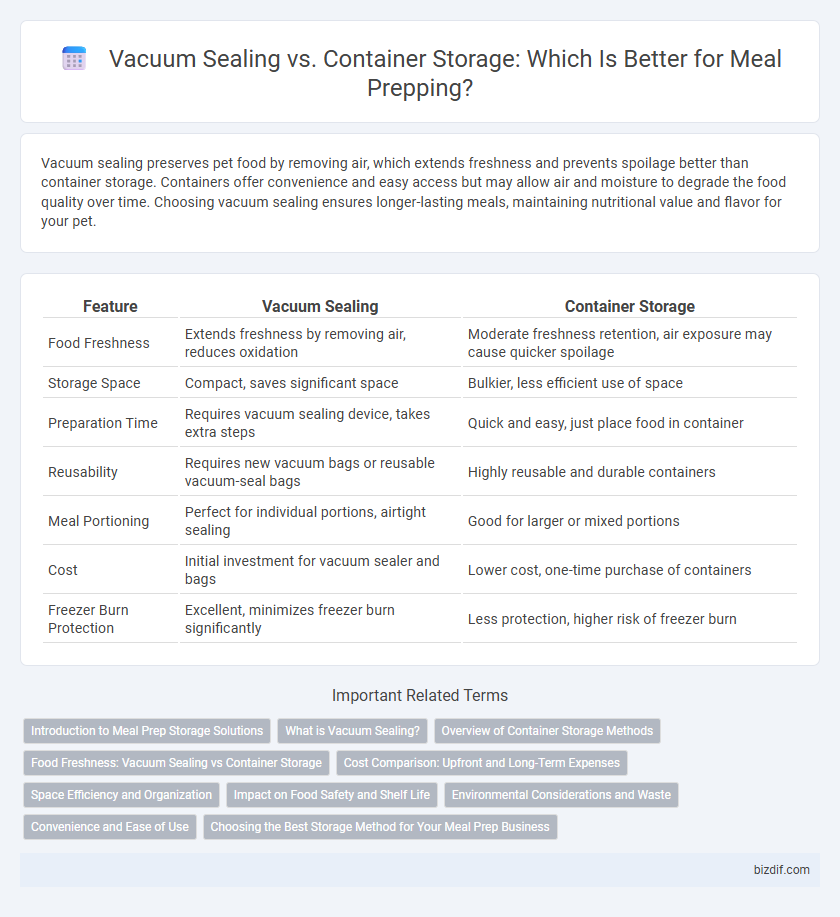Vacuum sealing preserves pet food by removing air, which extends freshness and prevents spoilage better than container storage. Containers offer convenience and easy access but may allow air and moisture to degrade the food quality over time. Choosing vacuum sealing ensures longer-lasting meals, maintaining nutritional value and flavor for your pet.
Table of Comparison
| Feature | Vacuum Sealing | Container Storage |
|---|---|---|
| Food Freshness | Extends freshness by removing air, reduces oxidation | Moderate freshness retention, air exposure may cause quicker spoilage |
| Storage Space | Compact, saves significant space | Bulkier, less efficient use of space |
| Preparation Time | Requires vacuum sealing device, takes extra steps | Quick and easy, just place food in container |
| Reusability | Requires new vacuum bags or reusable vacuum-seal bags | Highly reusable and durable containers |
| Meal Portioning | Perfect for individual portions, airtight sealing | Good for larger or mixed portions |
| Cost | Initial investment for vacuum sealer and bags | Lower cost, one-time purchase of containers |
| Freezer Burn Protection | Excellent, minimizes freezer burn significantly | Less protection, higher risk of freezer burn |
Introduction to Meal Prep Storage Solutions
Vacuum sealing preserves freshness by removing air and preventing oxidation, extending the shelf life of meal preps up to five times longer than traditional containers. Container storage offers convenience and stackability with reusable, BPA-free options ideal for portion control and quick access. Choosing between vacuum sealing and container storage depends on the need for long-term preservation versus everyday usability.
What is Vacuum Sealing?
Vacuum sealing is a food storage method that removes air from specially designed bags before sealing them tightly to preserve freshness and extend shelf life. This technique minimizes oxidation and inhibits bacterial growth, making it ideal for meal prepping by maintaining the flavor, texture, and nutritional value of stored food. Compared to traditional container storage, vacuum sealing significantly reduces freezer burn and moisture loss, ensuring meals stay fresh longer.
Overview of Container Storage Methods
Container storage methods for meal prepping include glass, plastic, and stainless steel options, each offering benefits like durability and ease of cleaning. Glass containers are favored for their non-reactive surface and microwave-safe properties, while BPA-free plastic containers are lightweight and budget-friendly. Airtight, stackable containers help preserve freshness by minimizing air exposure and organizing meals efficiently in the fridge or freezer.
Food Freshness: Vacuum Sealing vs Container Storage
Vacuum sealing significantly extends food freshness by removing air that causes oxidation and bacterial growth, preserving nutrients and flavor for up to five times longer than traditional container storage. Containers, while convenient, allow minimal air exchange that accelerates spoilage and moisture loss, reducing shelf life to a few days. For meal prepping, vacuum sealing is the superior method for maintaining optimal food quality and preventing freezer burn.
Cost Comparison: Upfront and Long-Term Expenses
Vacuum sealing requires investing in a vacuum sealer machine, with prices typically ranging from $30 to $200, plus the ongoing cost of vacuum bags averaging $0.30 to $1 per bag. Container storage involves purchasing reusable containers, which can cost between $10 to $50 for a set, but eliminates continuous expenses as containers are durable and reusable. Long-term, vacuum sealing may incur higher costs due to consumable bags, while containers offer a more cost-effective solution for repeated meal prepping.
Space Efficiency and Organization
Vacuum sealing significantly enhances space efficiency by compressing food to reduce bulk and allowing flat stacking, maximizing refrigerator and freezer capacity. Containers offer easier organization with transparent designs and compartment options but occupy more space due to rigid shapes and air-filled gaps. Choosing vacuum sealing optimizes storage density, while containers provide straightforward food visibility and separation for meal prepping.
Impact on Food Safety and Shelf Life
Vacuum sealing significantly extends the shelf life of meal preps by removing air and reducing oxygen exposure, which inhibits bacterial growth and slows spoilage compared to traditional container storage. Vacuum-sealed meals maintain freshness for up to 1-2 weeks in the refrigerator and several months in the freezer, while container-stored food typically lasts only 3-5 days refrigerated. This method also helps retain nutrient quality and prevents freezer burn, enhancing overall food safety and meal preservation.
Environmental Considerations and Waste
Vacuum sealing significantly reduces food spoilage and waste by extending the shelf life of meals through airtight preservation, making it an environmentally efficient option for meal prepping. Unlike single-use plastic containers, vacuum-sealed bags can often be reused or recycled depending on the material, lowering overall waste generation. Container storage, however, often involves durable, reusable materials like glass or BPA-free plastic that reduce the carbon footprint over time but may contribute to higher initial environmental costs due to manufacturing.
Convenience and Ease of Use
Vacuum sealing offers superior convenience by significantly extending freshness and reducing freezer burn, making it ideal for long-term meal prepping with minimal maintenance. Container storage provides straightforward accessibility and easy stacking in refrigerators, simplifying quick meal grabs and portion control. Choosing between the two depends on balancing airtight preservation benefits against user-friendly organization and immediate usability.
Choosing the Best Storage Method for Your Meal Prep Business
Vacuum sealing extends meal freshness by removing air, reducing spoilage, and preserving nutrients, making it ideal for bulk or long-term storage in meal prep businesses. Container storage offers convenience and quick access for daily or short-term meals but may require refrigeration to maintain quality. Selecting the best storage method depends on your business's scale, delivery timeline, and menu variety to optimize food safety and customer satisfaction.
Vacuum Sealing vs Container Storage Infographic

 bizdif.com
bizdif.com